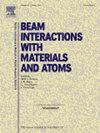Analytical model of light ions reflection from solids
IF 1.4
3区 物理与天体物理
Q3 INSTRUMENTS & INSTRUMENTATION
Nuclear Instruments & Methods in Physics Research Section B-beam Interactions With Materials and Atoms
Pub Date : 2025-01-11
DOI:10.1016/j.nimb.2024.165610
引用次数: 0
Abstract
The paper presents an analytical theory for describing the angular and energy distributions of medium energies light ions reflected from solids. This analytical theory is based on the phenomenological method of electrons reflection from solids named Oswald-Kasper-Gaukler method (OKG), which was successfully verified for electron spectroscopy. It is shown, that OKG method is based on the solution of boundary value problem for the transfer equation using the invariant imbedding method in the small-angle approximation. The main advantage of OKG method is an opportunity for the description of atomic particles reflection processes from solids by means of spherical harmonics method. Presented analytical formulas determine all scattering characteristics of reflected particles using dimensionless parameter, which is the ratio of the residual range to the transport length, and differential elastic cross section ωel(n0,n). Energy losses of ions in solids are calculated using Fokker-Plank approximation. Differential elastic cross sections are calculated in first Born approximation using Kr-C potential. The value of the parameter which determines the differential elastic cross section on small angles is determined by the ratio of the de Broglie wavelength of incidence particle to the screening radius a = 0.8853a0(Z11/2 + Z21/2)-2/3, where a0 – first Bohr radius and was corrected in the range determined in Moliere works.
For elastic scattering of protons, the path length distribution function (PLDF) was found. The function was tested by comparison with the results of computer simulations performed using the binary-collision simulation program SPIM-L. Analytical results are also compared with experimental angular and energy spectra of 0.1–30 keV protons reflected from Be, C, Al, Ti, Ni, Cu and W targets. Satisfactory agreement between the theoretical and experimental results was found.
For the ions initial energies of hundreds of eV energy spectra of reflected protons were compared with results of computer simulation by means of MARLOWE program. The satisfactory agreement between the analytical, experimental and simulation results means the opportunity of the description not only electron scattering processes, but also the processes of light ions reflection from solids by means of OKG method.

固体光离子反射的解析模型
本文提出了一种描述固体反射中能光离子的角分布和能量分布的解析理论。该分析理论是基于固体电子反射的现象学方法Oswald-Kasper-Gaukler方法(OKG),该方法已成功地在电子能谱中得到验证。结果表明,OKG方法是基于在小角度近似下用不变嵌入法求解传递方程边值问题。OKG方法的主要优点是有机会用球谐法描述原子粒子从固体的反射过程。给出了利用残余距离与输运长度之比和微分弹性截面ωel(n0,n)等无量纲参数确定反射粒子散射特性的解析公式。采用Fokker-Plank近似法计算固体中离子的能量损失。微分弹性截面用k - c势在第一玻恩近似下计算。决定小角度上微分弹性截面的参数值由入射粒子的德布罗意波长与屏蔽半径之比a = 0.8853a0(Z11/2 + Z21/2)-2/3确定,其中a0 -第一玻尔半径在莫里哀著作中确定的范围内进行了修正。对于质子的弹性散射,建立了路径长度分布函数(PLDF)。通过与计算机模拟结果的比较,验证了该函数的有效性。对比了0.1 ~ 30 keV质子在Be、C、Al、Ti、Ni、Cu和W靶上反射的实验角能谱和能谱。理论与实验结果吻合较好。用MARLOWE程序对离子在数百eV的初始能与反射质子能谱进行了比较。分析结果、实验结果和模拟结果之间的一致性令人满意,这意味着不仅有机会描述电子散射过程,而且有机会用OKG方法描述固体光离子反射过程。
本文章由计算机程序翻译,如有差异,请以英文原文为准。
求助全文
约1分钟内获得全文
求助全文
来源期刊
CiteScore
2.80
自引率
7.70%
发文量
231
审稿时长
1.9 months
期刊介绍:
Section B of Nuclear Instruments and Methods in Physics Research covers all aspects of the interaction of energetic beams with atoms, molecules and aggregate forms of matter. This includes ion beam analysis and ion beam modification of materials as well as basic data of importance for these studies. Topics of general interest include: atomic collisions in solids, particle channelling, all aspects of collision cascades, the modification of materials by energetic beams, ion implantation, irradiation - induced changes in materials, the physics and chemistry of beam interactions and the analysis of materials by all forms of energetic radiation. Modification by ion, laser and electron beams for the study of electronic materials, metals, ceramics, insulators, polymers and other important and new materials systems are included. Related studies, such as the application of ion beam analysis to biological, archaeological and geological samples as well as applications to solve problems in planetary science are also welcome. Energetic beams of interest include atomic and molecular ions, neutrons, positrons and muons, plasmas directed at surfaces, electron and photon beams, including laser treated surfaces and studies of solids by photon radiation from rotating anodes, synchrotrons, etc. In addition, the interaction between various forms of radiation and radiation-induced deposition processes are relevant.

 求助内容:
求助内容: 应助结果提醒方式:
应助结果提醒方式:


